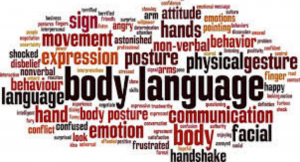
By Zainub Jada
27:11:2020
‘Of all the things you wear, your expression is the most important!’ Janet Lane
What Is Body Language?
Body language is a type of non-verbal communication in which physical behaviours, as opposed to words, are used to express or convey information. Such behaviour includes facial expressions, body posture, gestures, eye movement, touch and the use of space.
The conscious and unconscious movements and postures by which attitudes and feelings are communicated.
In essence body language is the unspoken element of communication that we used to reveal our true feelings and emotions.
When we can “read” these signs, we can use it to our advantage. For example, it can help us to understand the complete message of what someone is trying to say to us and to enhance our awareness of people’s reactions to what we say and do.
We can also use it to adjust our own body language so that we appear more positive, engaging and approachable.
The ability to understand and to interpret body language can help you to pick up on unspoken issues, problems or negative feelings that other people might have. You can also use it positively to add strength to your verbal messages.
It has been suggested that body language may account for between 60 to 65% of all communication.
Body language can also help you to stay calm in situations where emotions have the potential to run high e.g.: a negotiation
Body language plays an essential role in how we share information with others.
Body Language Principles
How to Read People’s Body Language
There are actually two sides to reading body language in others.
1-Decoding is your ability to read people’s cues. It is how you interpret hidden emotions, information and personality from someone’s non-verbal communication.
2-Encoding is your ability to send cues to other people. This is how you control your personal branding, what first impression you give and how you make people feel when they are with you.
Facial Expressions
The most universal form of body language
Facial expressions may reveal our true feelings about a particular situation. While you say that you are feeling fine, the look on your face may tell people otherwise.
Few examples of emotions that can be expressed via facial expressions include:
1-Happiness
2-Sadness
3-Anger
4-Surprise
5-Disgust
6-Fear
7-Confusion
8-Excitement
9-Desire
10-Contempt
Smiling
The greatest body language signal
Smiles can also be interpreted in many ways.
A smile may be genuine, or it may be used to express false happiness, sarcasm, or even cynicism
When evaluating body language, pay attention to the following mouth and lip signals:
1-Pursed lips
Tightening the lips might be an indicator of distaste, disapproval, or distrust.
2-Lip biting
People sometimes bite their lips when they are worried, anxious, or stressed.
3-Covering the mouth.
When people want to hide an emotional reaction, they might cover their mouths to avoid displaying smiles or smirks.
4-Turned up or down.
Slight changes in the mouth can also be a subtle indicator of what a person is feeling. When the mouth is slightly turned up, it might mean that the person is feeling happy or optimistic. On the other hand, a slightly down-turned mouth can be an indicator of sadness, disapproval, or even an outright grimace.
How Reliable Is Body Language?
Body language is not only powerful; it’s usually reliable for revealing your true feelings, too. However, body language isn’t completely reliable if the person expressing it knows how to manipulate it well.
Body language comes through most of the time whether you intend to reveal it or not. However, you need to be careful when assessing someone else’s body language. You may interpret body language one way, but the gesture may mean something entirely different to someone else. When reading body language this is particularly important to know when there are cultural differences between people.
Cultural differences
Someone’s cultural background can have a big influence on how they use and read body language.
In many Western cultures, eye contact while speaking suggests openness and interest.
People of other cultures, including many Eastern cultures, may avoid prolonged eye contact, as looking slightly down or to the side may seem more respectful.
Nodding indicates agreement in many cultures. In others, it might just mean the other person acknowledges your words.
Negative Body Language
Being aware of negative body language in others can allow you to pick up on unspoken issues or bad feelings. Negative non-verbal signals may include difficult conversations and defensiveness.
Difficult or tense conversations are an uncomfortable fact of life be it at work or in the home. Perhaps you’ve had to deal with a difficult customer/partner or needed to talk to someone about his or her poor performance. Or maybe you’ve negotiated a major contract.
Ideally, these situations would be resolved calmly. But, often they are complicated by feelings of nervousness, stress, defensiveness, or even anger. And, though we may try to hide them, these emotions often show through in our body language.
Negative body language can keep you from getting the things you want. What’s more, it can cause you to lose friends, miss out on opportunities at work, or offend people you want to impress.
Negative body language includes:
1-Folded arms.
2-Tense facial expression.
3-Body turned away from you.
4-Poor eye contact/Gazing at something else, or into space.
5-Sitting slumped, with heads downcast.
6-Fidgeting, picking at clothes, or fiddling with pens and phones.
7-Writing or doodling.
Once you have realized and noticed that someone is disengaged, you’re now in a better position to do something about it. For example, you can re-engage her by asking her a direct question, or by inviting her to contribute an idea of her own.
Positive Body Language
Positive body language can help you get what you want if you know how to use it. It can land you a job, help you sell your house, win an argument, or start a relationship.
How to Project Positive Body Language
When you use positive body language, it can add strength to the verbal messages or ideas that you want to convey, and help you to avoid sending mixed or confusing signals. Positive body language projects self-confidence and openness.
1-Making a Confident First Impression
Have an open posture. Be relaxed, but don’t slouch!
Sit or stand upright and place your hands by your sides. Avoid standing with your hands on your hips, as this will make you appear larger, which can communicate aggression or a desire to dominate
2-Use a firm handshake. But don’t get carried away!
You don’t want it to become awkward or, worse, painful for the other person. If it does, you’ll likely come across as rude or aggressive.
3-Maintain good eye contact.
Try to hold the other person’s gaze for a few seconds at a time. This will show her that you’re sincere and engaged. But, avoid turning it into a staring match!
4-Avoid touching your face.
There’s a common perception that people who touch their faces while answering questions are being dishonest. While this isn’t always true, it’s best to avoid fiddling with your hair or touching your mouth or nose, particularly if you aim to come across as trustworthy.
5-Use mirroring
If you can, subtly mirror the body language of the person you’re talking to. This will make him feel more at ease and can build rapport. But don’t copy every gesture that he makes, as this will likely make him feel uncomfortable, or that you’re not taking him seriously.
How to Send the Right Messages with Your Body Language
Learning body language is a great first step in sending the right body language messages. It also helps you read the unspoken messages and non-verbal signals that others are sending to you.
However, knowing the right movements, gestures, and facial expressions can only take you so far. If you want to have healthy, productive interactions with others, you may need to work toward a better understanding of yourself and the people in your life.
Putting it all together
Body language can be complex and difficult to understand.
Slight shifts in stance and changes in facial expression tend to happen naturally over the course of a conversation or social interaction. Though, someone with a consistently erect posture or fixed expression may be putting in a lot of effort to keep their true emotions from showing.
If you have a hard time understanding body language, keep these tips in mind:
1-Talk to them. It never hurts to ask someone how they feel. If you notice a restless foot or clenched fists, try pulling them aside and asking if everything’s all right.
2-Consider their previous body language. Body language can vary from person to person. If someone’s unique body language suddenly seems different, it’s a clue that something might be going on beneath the surface.
3-Aim for some level of eye contact. You don’t have to stare or maintain continuous eye contact, but it does help to meet someone’s gaze and hold it for the better part of a conversation. Plus, you’re more likely to pick up on body language when you’re looking at the person.
4-Remember to listen. Good communication always involves listening. Don’t get too caught up in trying to decipher someone’s gestures or position that you forget to listen to their words.
Generally speaking, you can’t get a complete picture of what others think and feel based on their body language alone. When you put body language in the context of their words, you may get a lot more information than you would when considering either type of communication alone.
Bibliography
1-scienceofpeople.com
2-betterhelp.com
3-verywellmind.com
4-healthline.com
5-mindtools.com







0 Comments